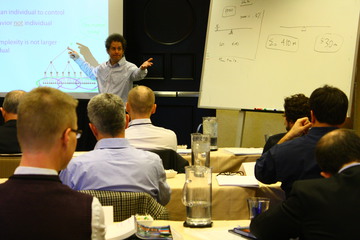Reader Garin (thanks!) pointed me to this Al Jazeera video from 2013 that I missed. Interesting and unusual video format.
Tag Archives: antifragility
Antifragility | NECSI
The program will include lessons from Taleb’s current research and his New York Times bestseller Antifragile, including:
How to spot fragility
What antifragility is
Why it is better to be antifragile than smart
How not to mistake a cat for a washing machine
Heuristics and rules to simplify life and decision making
These will be paired with insights from Yaneer Bar-Yam’s current research and book Making Things Work, drawing upon case studies from financial markets, healthcare, systems engineering, the military, and other topics. Lessons include:
What complexity is Ways to recognize and use important patterns in a complex world How to harness the power of self-organization to be naturally antifragile
How to assess the metaview
Global risks, cascading crises, and the “new normal”Participants will be part of an open discussion and will leave with tools relevant to their organizations.
Source: Antifragility | NECSI
NECSI Executive Education: Antifragility | NECSI
NECSI Executive Education: Antifragility
Antifragility: A User’s Manual
Learn to flourish in a volatile and complex world by creating “antifragile” organizations that thrive on stress and disorder. A two-day program for senior management January 21st and 22nd, 2016 Cambridge, MA
Speakers:Nassim Nicholas Taleb, Former trader,author of The Black Swan and AntifragileYaneer Bar-Yam, President and Professor,New England Complex Systems Institute
Frame:When strong winds blow, don’t build walls, but rather windmills: there is a way to turn every bit of adversity into fuel for improvement.This course introduces the principles of antifragility and complex systems science to explain how organizations and markets respond to volatility. Participants will learn which organizations can be considered fragile or antifragile, why certain patterns and trends matter while others are just noise, and how to create organizations that use volatility, variability, stress and disorder as information for making better decisions. This program does not require a math background.
NNT on Reason TV!
Treat! From Reason.com
Reason’s Nick Gillespie sat down with Taleb for a wide-ranging discussion about why debt leads to fragility (5:16); the importance of “skin in the game” to a properly functioning financial system (10:45); why large banks should be nationalized (21:47); why technology won’t rule the future (24:20); the value of studying the classics (26:09); his intellectual adversaries (33:30); why removing things is often the best way to solve problems (36:50); his intellectual influences (39:10); why capitalism is more about disincentives than incentives (43:10); why large, centralized states are prone to fail (44:50); his libertarianism (47:30); and why he’ll never take writing advice from “some academic at Cambridge who sold 2,200 copies” (51:49).
Friend, my central point…
But the average of the function is as follows. Take the square of every payoff, 1^2+2^2+3^2+4^2+5^2+6^2 divided by 6, that is the average square payoff, and you get 15.67. So, since squaring is a convex function, the average of a square payoff is higher than the square of the average payoff. The difference, here between 15.67 and 12.25 is what I call the hidden benefit of antifragility —here 28 percent “edge”. The conflation problem mistaking a property of a function of something for the function of the property of something leads to severe misunderstanding of the process.
The hidden benefit of antifragility is that you can guess worse than random and still end up outperforming. Here lies the power of optionality —your function of something is very convex, so you can be wrong and still do fine —the more uncertainty , the better.The hidden harm of fragility is that you need to be much, much better than random in your prediction and knowing where you are going, just to offset the negative effect.The property is called Jensen’s inequality and I use a variant of it. This is what the common discourse on innovation is missing. If you ignore Jensen’s inequality, you are missing a chunk of makes the nonlinear world go round. And it is the fact that such idea s missing totally from the discourse. Sorry.
